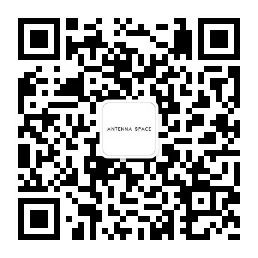Booth No. W29
November 13, 2024 – November 16, 2025
Shanghai Exhibition Center
Participating Artists:Cui Jie, Guillaume Dénervaud, Owen Fu, Guan Xiao, Li Ming, Shuang Li, Siyi Li, Li Yong Xiang, Noel McKenna, Tan Jing, Evelyn Taocheng Wang, Yu Honglei, Zhou Siwei.
ART021 Shanghai Contemporary Art Fair 2025
Antenna Space is pleased to announce that it will bring artists Cui Jie, Guillaume Dénervaud, Owen Fu, Guan Xiao, Li Ming, Shuang Li, Siyi Li, Li Yong Xiang, Noel McKenna, Tan Jing, Evelyn Taocheng Wang, Yu Honglei and Zhou Siwei to the ART021 Contemporary Art Fair in Shanghai at 2025, Booth No. W29.
–
Installation view
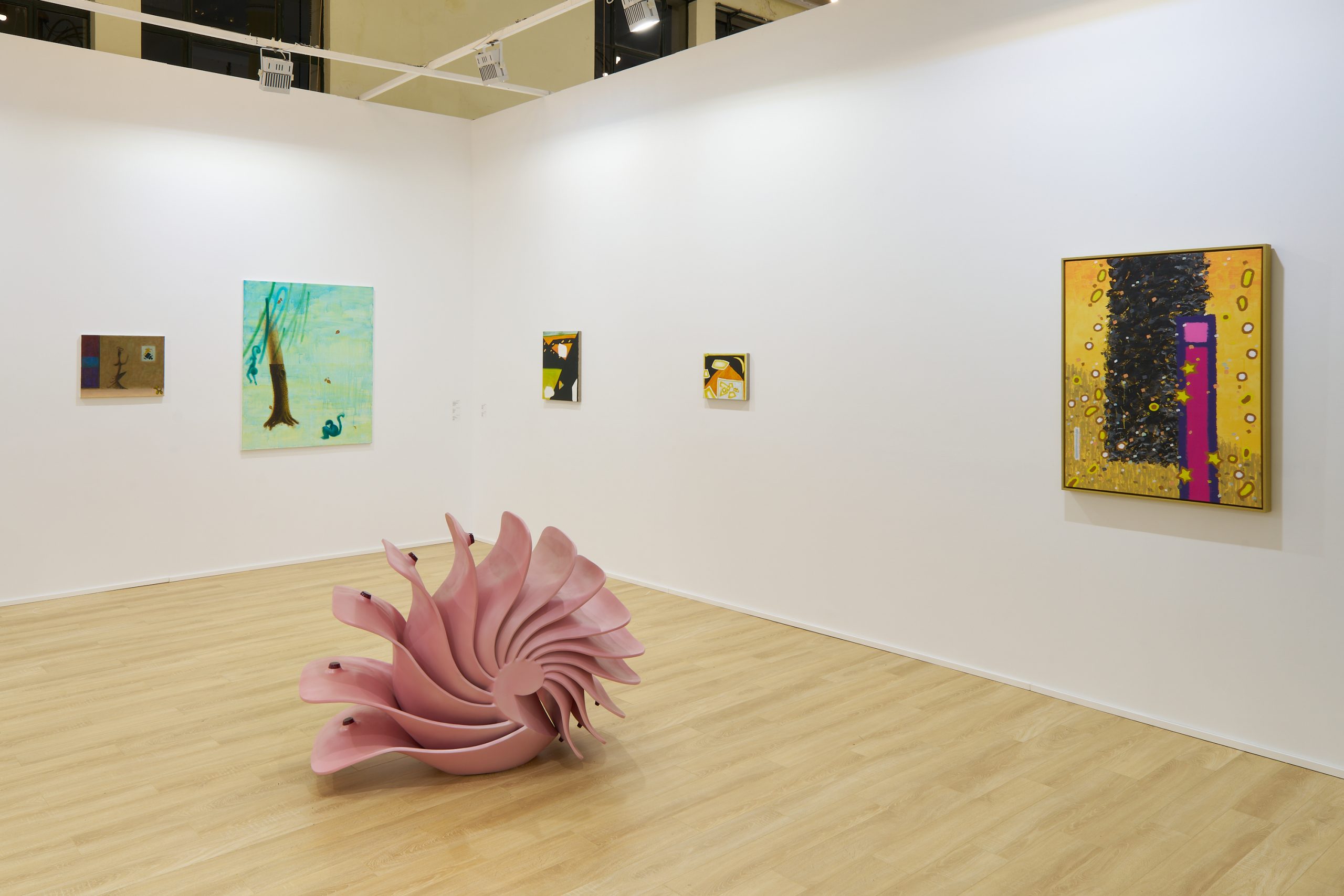
In Yu Honglei’s Vertical Night – Orange Highway Warrior, the composition hovers between narrative and abstraction, constructing a horizon-less space that resembles a paused frame from a trajectory in motion. The picture is built from diagonal forces, vertical structures, and floating fragments, forming a looping visual current. The visual weight unfolds from the upper left toward the lower right: a red form in the upper left cuts in like an arrow, activating a tilted momentum; the vertical orange band on the right counterbalances this inclination like a spine of energy, allowing the image to remain stable amid its flow. The floating fragments resemble traces of wind—frozen events, or moments captured mid-journey. Abstraction does not reject narrative; rather, it uses symbolic elements to suggest the relationships among movement, will, and imagination. The red incision, the blue vortex, and the drifting fragments together form a psychological map that records the trajectory of consciousness moving through the night.
Shuang Li’s This is how I disappear draws inspiration from fan cultures surrounding underground rock bands, with a particular focus on the emotional bonds within youth subcultures. The work transforms emotional tension into spatial structure, its form borrowing from the organic spiral growth inside a nautilus shell. Pink tonalities intertwine and spread, evoking both the restless atmosphere of a gathering crowd and a tension between visibility and concealment. Fragmented bodily forms and blurred projected imagery communicate a paradoxical state: the desire to hide, yet also the longing to express.
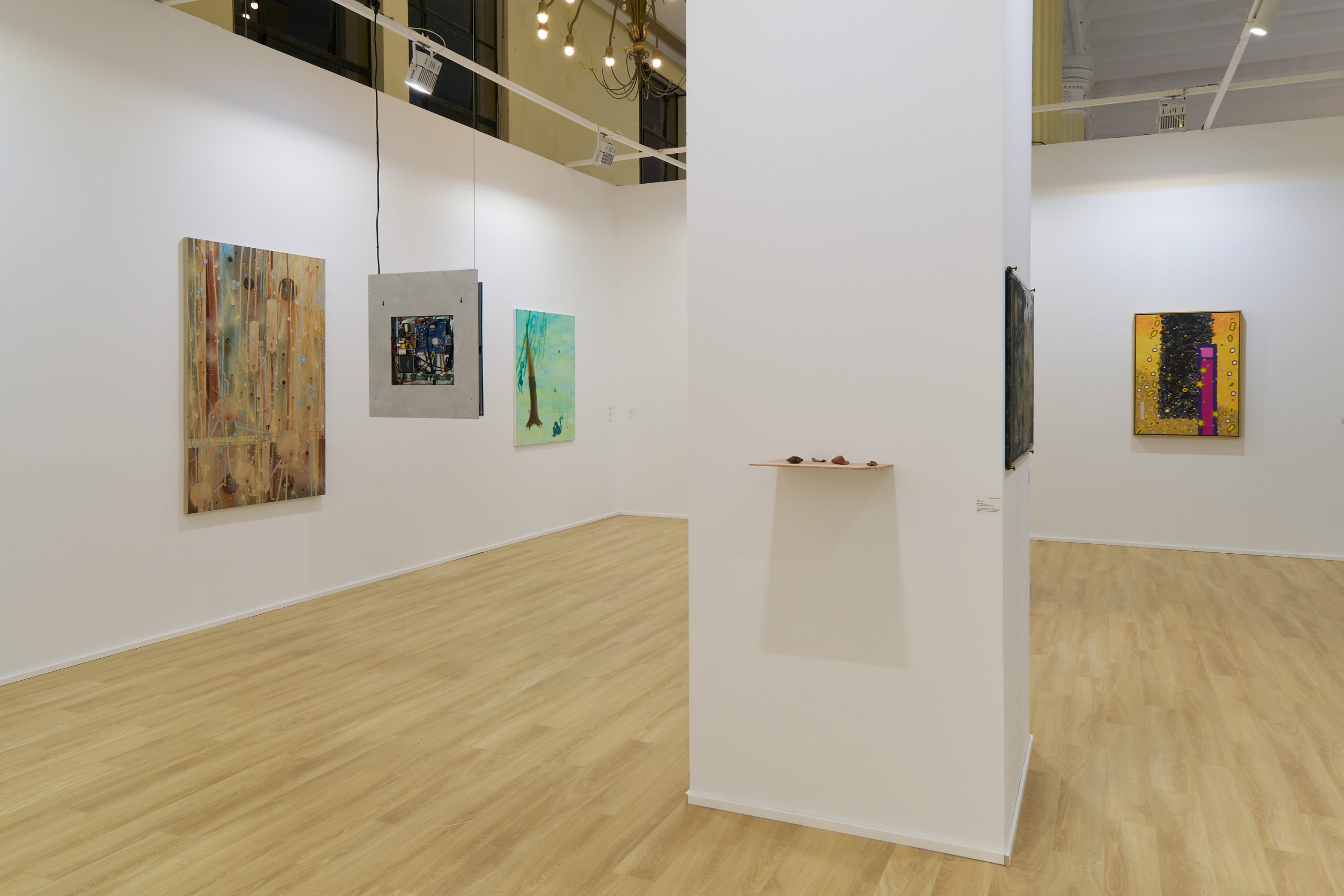
Guillaume Dénervaud working in his characteristic interlacing of oil paint and pencil, depicts a world that appears to be undergoing recalibration. Layers of lines and color fields resemble microscopic neural networks or liquid circuits, as if responding to an invisible regulatory command. Organic, flowing forms are placed within an artificial order, oscillating continuously between balance and disturbance.
In Li Ming’s new work Inspired by Transliteration – Chapter Seven: The New Angel Runway, seized by a swarm of pixel particles, is dragged backward in flight, wings outstretched, facing a ruin rather than the future—a ruin stitched together from “fragments (data-scrapes)” of the past: indistinct landscapes, fractured childhoods, expired caches of memory, and dreams that never finished loading. The work is inspired by Walter Benjamin’s reading of Paul Klee’s 1920 painting Angelus Novus. As the seventh chapter of the Inspired by Transliteration cycle, it clasps hands with Chapter Two, Emergency Exit (2017): palm pressed to palm, “escape” and “flight” form a counterpoint—one institutionalized (the green glow of the safety passage), the other individualized (a desperate, lucid flight on foot). The New Angel Runway sets human chanting against AI-generated imagery. Prompt-writing here functions as the casting of spells: each prompt is an instruction flung to the machine, summoning an image. Every prompt is, in truth, a kind of blind shot—a rejection of the camer —through a succession of failures, annulments, retrainings, and feedback loops, until the image approaches “itself.” In this sense, blind shooting re-centers creation away from linguistic control.
Tan Jing’s A Site of Yearing (The Boudoir)#3 grows out of the artist’s research into desire, scent, and affective atmospheres in Ming–Qing literature. What appear to be scattered petals are in fact handmade incense wafers crafted by the artist, derived from historical formulas such as douqing xiang (Tempting Incense) and zhangzhong xiang (Tent Incense)—sweet, intoxicating fragrances that were historically dismissed in East Asia as lowly “boudoir” or carnal scents, burdened with both aesthetic and moral stigma. The ceramic support investigates porosity as a material condition; its mottled surface evokes the way ink seeps into a tabletop. The scent materials in the work, precisely because of their permeating nature, become sources of fear and agents of control. During the exhibition, the incense is lit, turning the surrounding area into a minimal unit of intimacy. The scattered ashes, too, become part of the work’s trace.

In Angel and Imitation of Agnes Martin, Evelyn Taocheng Wang juxtaposes two seemingly divergent visual vocabularies. In the background, Agnes Martin’s minimalist, orderly grid is mimicked and internalized as a quiet structural armature. In the foreground, however, appears a crudely rendered “angel,” whose form is based on the Angel Crowning the Virgin and Child painted after 1474 by the fifteenth-century Netherlandish artist known as the Master of the Gelder Madonna. The image functions simultaneously as a historical icon and as a site of contemporary perceptual dismantling. What, then, determines the legitimacy—or authority—of the angelic image today?
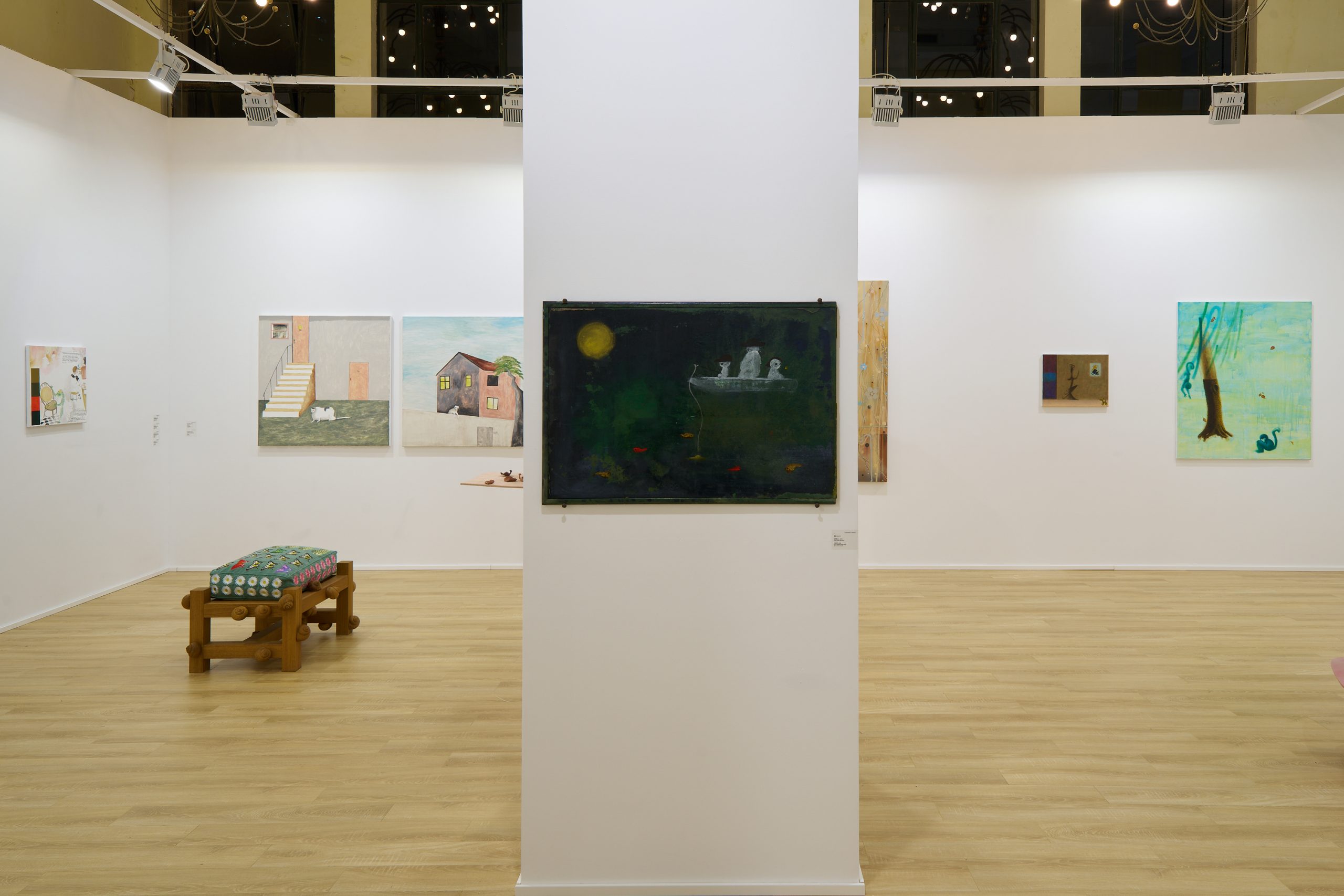
It’s mid-autumn.
A son, a father, and a son sit together under the full moon.
No one says much.
This sentence echoes the fragment Owen Fu wrote for Three Under The Moon.
Noel McKenna weaves personal experience with the subtle textures of daily life, creating images centered on animals and imbued with gentle imagination. The artist positions himself as both an attentive observer and companion to the pets that inhabit his works. In Augustus, Pet, the domestic creature assumes a significance surpassing that of human figures: it inhabits the room, moves through its corners, and reclines beneath the stairway like a quiet guardian. For McKenna, the emotional bond with pets endures across time; all animals, he believes, possess souls. His intent is to render them as vital presences within the pictorial space, revealing their complexity and quiet wonder.
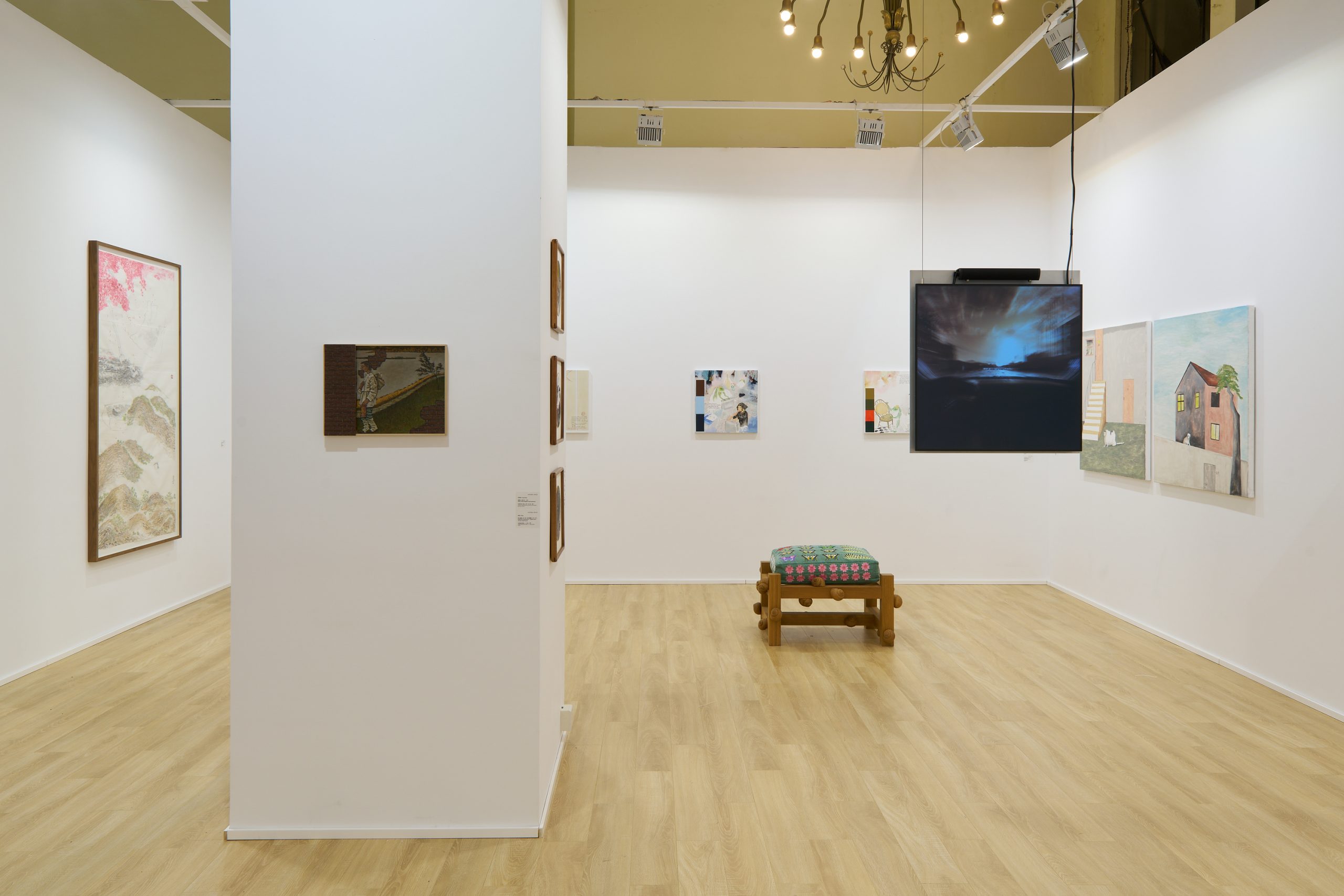
This group of works extends Li Yong Xiang’s March solo exhibition In Rust. The series deconstructs and reinterprets elements of In Rus’: The Soul of the People (1914–1916) by the early-twentieth-century Russian artist Mikhail Nesterov. In reflecting on the Peredvizhniki movement and Nesterov’s oeuvre, Li distances himself from the painter’s conservative interpretations and instead focuses on his eclectic stylistic language and the dreamlike religiosity embedded within it. According to Li’s reading, the works also carry a flattened aesthetic shaped by nineteenth-century European art movements from the latter half of the century—such as the Pre-Raphaelites and Art Nouveau. These multilayered artistic threads echo the central debates of the period and probe the shifting role of art between nation-building and a cosmopolitan spirit.
–
Images and texts courtesy of the artists and Antenna Space.
–
2025 Shanghai Contemporary Art Fair
Booth|W29
Venue: Shanghai Exhibition Center
Artworks
-

Zhou Siwei, Monkey (Fallen leaves, 5G wind), 2025
Oil on linen
120 x 100 cm
作品信息Information -
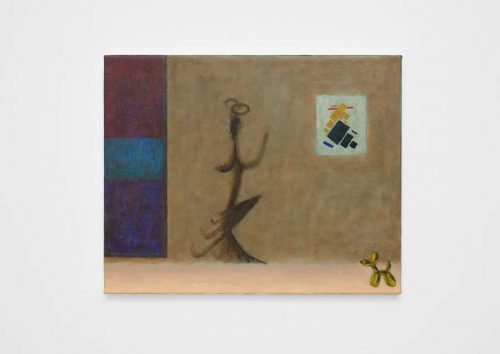
Zhou Siwei, Fairy (Old Art), 2025
Oil on linen
40 x 50 cm
作品信息Information -
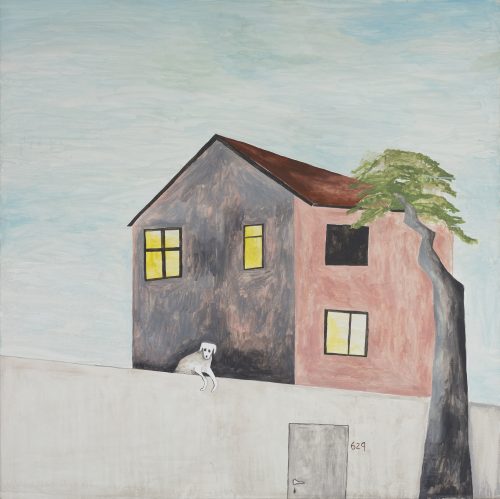
Noel McKenna, 629 Watermill Towd Road Watermill, 2017
Oil on canvas
100 x 100 cm
作品信息Information -
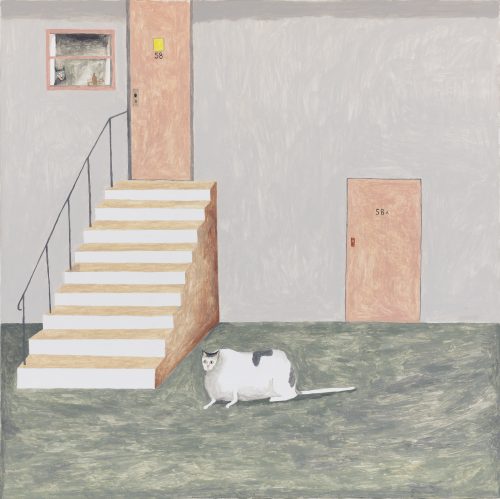
Noel McKenna, Augustus, Pet, 2023
Oil, acrylic on canvas
100 x 100 cm
作品信息Information -

Guillaume Dénervaud, They carefully adjusted the settings, 2025
Oil and pencil on linen
155 x 100 cm
作品信息Information -

Li Yong Xiang, Paint, In Rust (Imagined Youth Syndrome), 2025
Acrylic on primed linen mounted on hdf, beech
30 x 40 x 2.5 cm
作品信息Information -
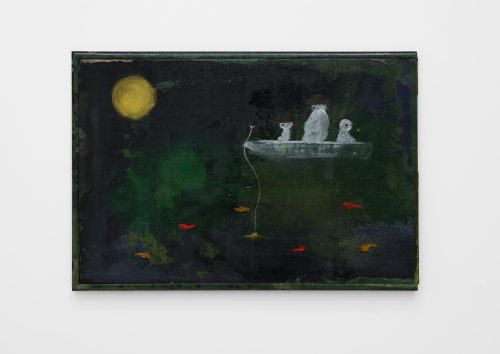
Owen Fu, Three Under the Moon, 2025
Oil on antique screen panel
60.5 x 87.5 x 1.5 cm作品信息Information -

Owen Fu, Untitled (The Wasted Times) , 2025
Mixed media on paper
21 cm (diameter)
33 x 33 cm (framed)作品信息Information -
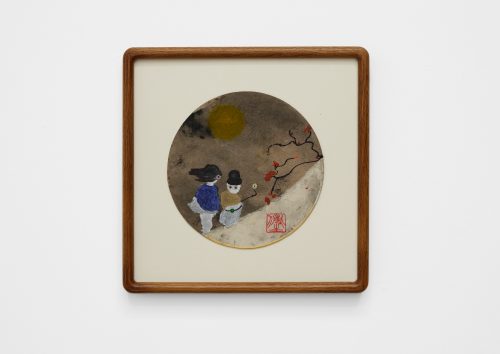
Owen Fu, Untitled (The Wasted Times) , 2025
Mixed media on paper
21 cm (diameter)
33 x 33 cm (framed)作品信息Information -
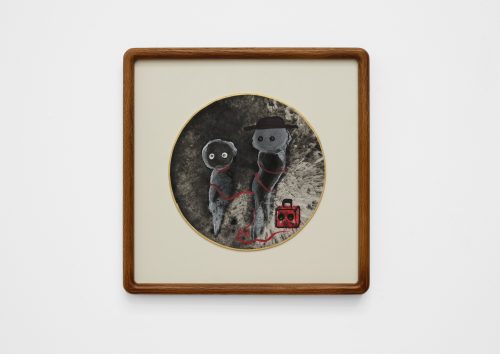
Owen Fu, Untitled (The Wasted Times) , 2025
Mixed media on paper
21 cm (diameter)
33 x 33 cm (framed)作品信息Information -

Cui Jie, Ceramic deers and Central Bank of West African States, Abidjan, 2025
Acrylic on canvas
250 x 180 cm作品信息Information -

Yu Honglei, Vertical Night – Orange Highway Warrior, 2025
Acrylic on canvas
240 x 180 cm作品信息Information -
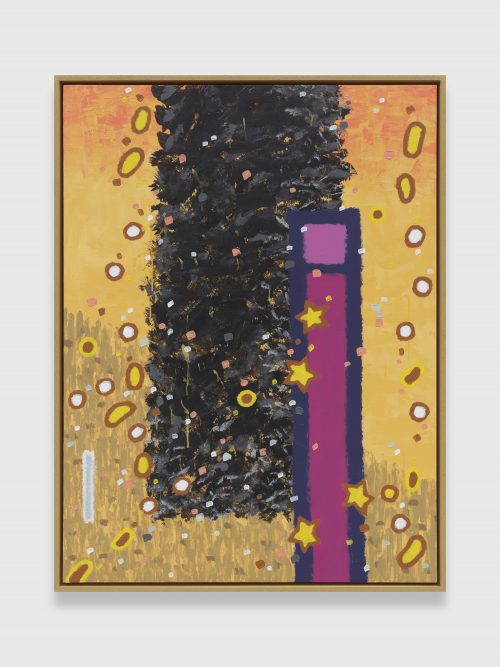
Yu Honglei, Sweet – 78.9%, 2025
Acrylic on canvas
103.5 x 78.5 cm
作品信息Information -
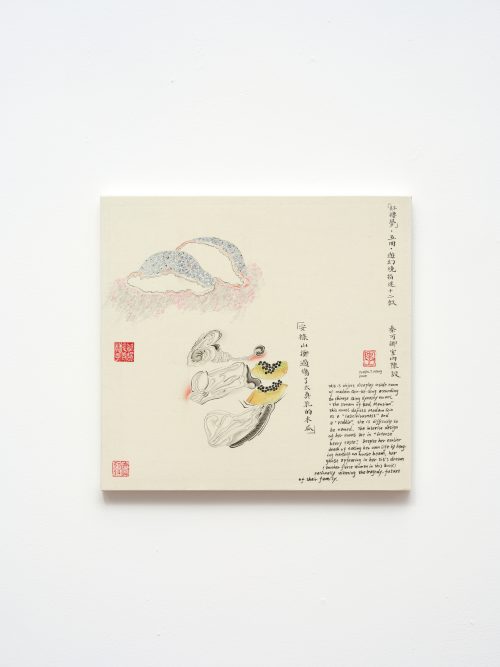
Evelyn Taocheng Wang, Quote on The Dream of Red Chamber, 2025
Calligraphy ink, mineral pigments, silk mounted on wooden board
38 x 40 cm作品信息Information -
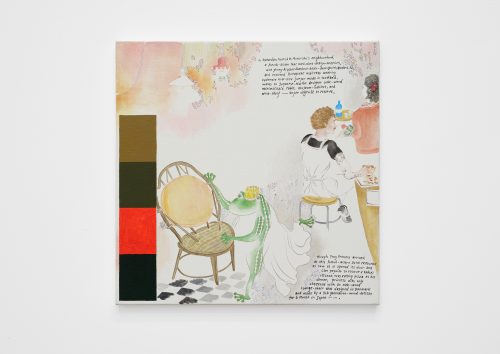
Evelyn Taocheng Wang, Frog Princess and Designer Chair, 2025
Oil, acrylic on linen
50 x 50 x 2.5 cm
作品信息Information -
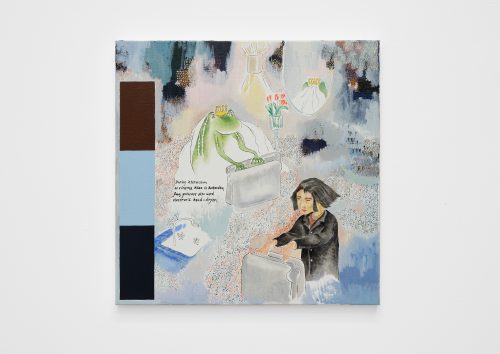
Evelyn Taocheng Wang, Frog Princess Used Electronic Hand-dryer During Movie Intermission, 2025
Oil on linen
50 x 50 x 2.5 cm
作品信息Information -
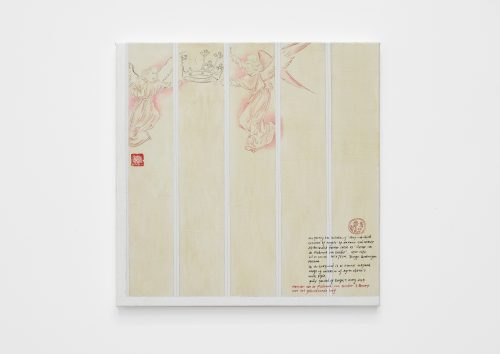
Evelyn Taocheng Wang, Angel and Imitation of Agnes Martin, 2025
Pencil, acrylic and gesso on linen
50 x 50 x 2.5 cm
作品信息Information -
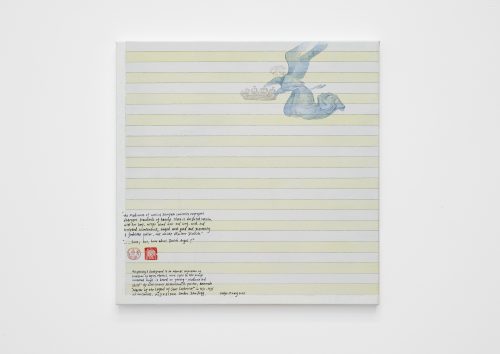
Evelyn Taocheng Wang, Angel and Imitation of Agnes Martin, 2025
Pencil, acrylic and gesso on linen
50 x 50 x 2.5 cm
作品信息Information -
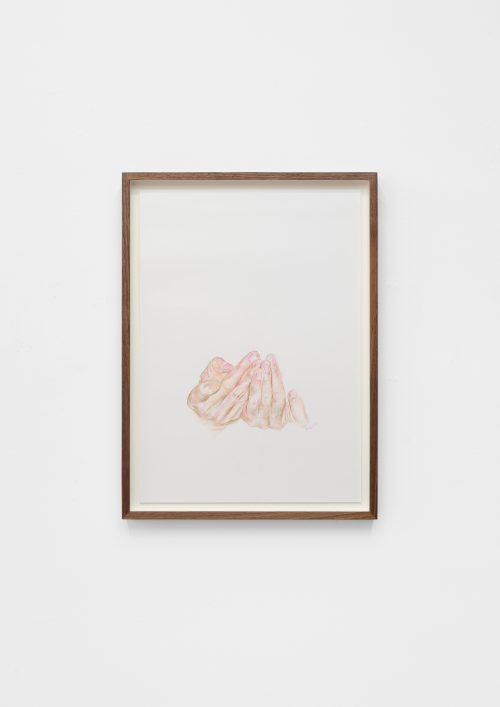
Siyi Li, untitled, 2025
Color pencil on paper
59.5 x 42 cm
65.5 x 48 x 5 cm (framed)作品信息Information -
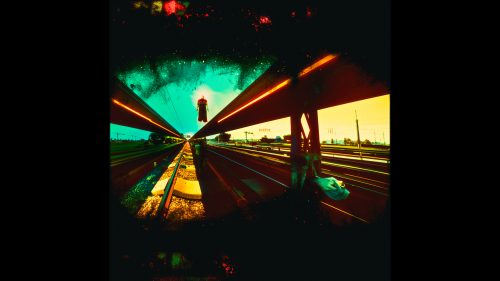
Li Ming, Inspired by Transliteration – Chapter Seven: The New Angel Runway, 2024-2025
Single-channel HD video, 1:1, color, sound, presented on CRT color monitor
Variable, depending on display equipment
00:13:13作品信息Information -

Guan Xiao, Fireworks, Sky, Love in your Mouth, 2020
Wood Panel, poly-putty base, acrylic colour
80 x 78 x 3.5 cm
作品信息Information -
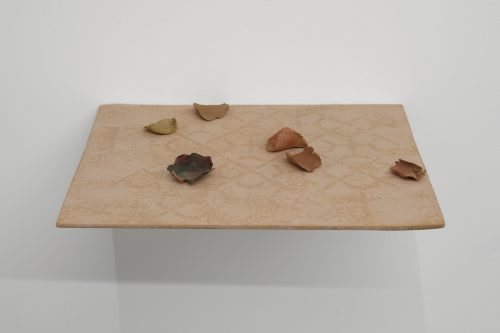
Tan Jing, A site of yearning (The Boudoir) #3, 2025
Pottery clay, decorative slip, sandalwood, agarwood, frankincense, synthetic musk, pear syrup, borneol
28 x 37 cm作品信息Information -
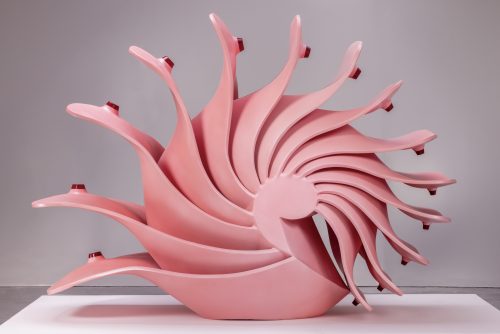
Shuang Li, This is how I disappear, 2023
Stainless steel, paint
94 x 79 x 53 cm
作品信息Information -

Siyi Li, untitled, 2025
Color pencil on paper
59.5 x 42 cm
65.5 x 48 x 5 cm (framed)作品信息Information -

Siyi Li, untitled, 2025
Color pencil on paper
59.5 x 42 cm
65.5 x 48 x 5 cm (framed)作品信息Information -

Siyi Li, untitled, 2025
Color pencil on paper
59.5 x 42 cm
65.5 x 48 x 5 cm (framed)作品信息Information -

Evelyn Taocheng Wang, Puzzle Game With Different Objects Indicate Women’s Tragedy Future, 2017
Ink, mineral color on rice paper
180 x 96 cm
作品信息Information -
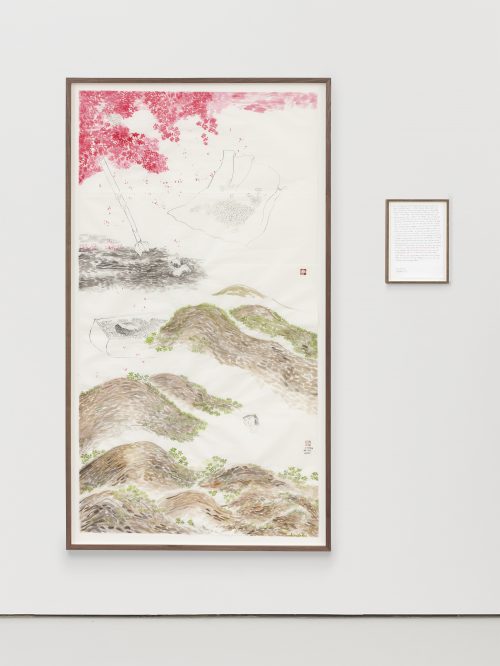
Evelyn Taocheng Wang, Bury Flowers, 2017
Ink, mineral color on rice paper
180 x 96 cm
作品信息Information
